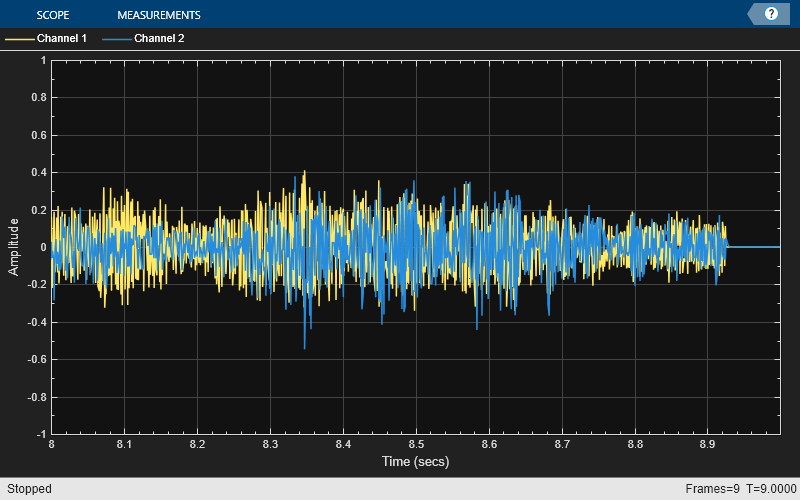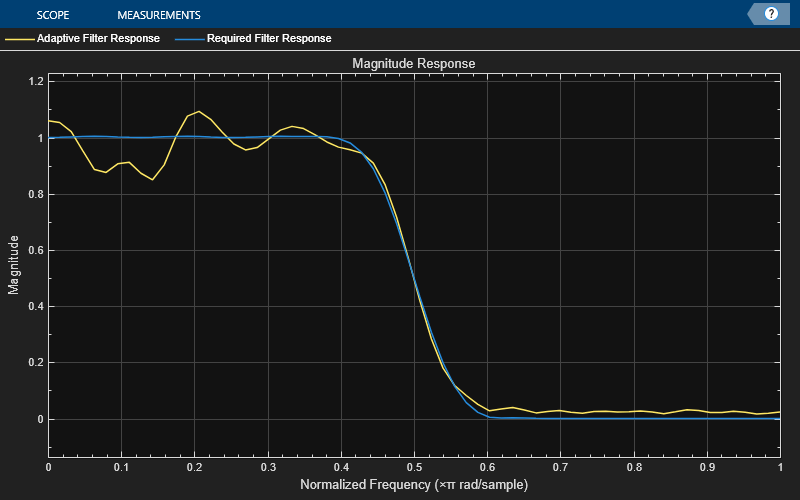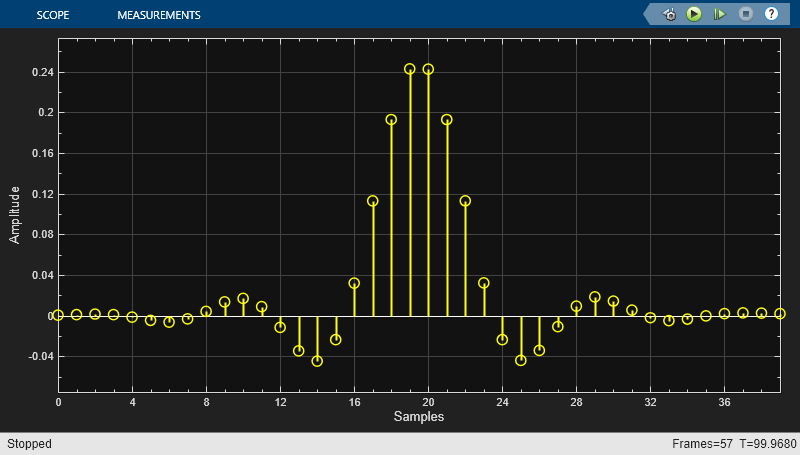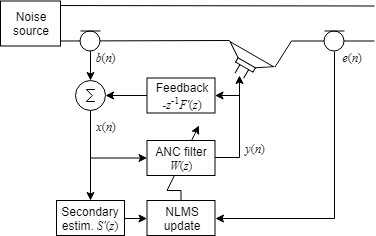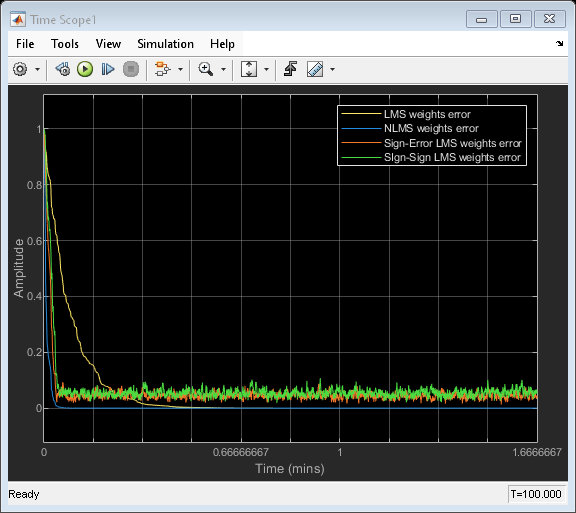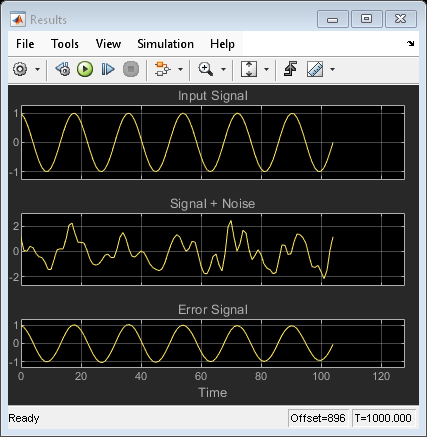自适应滤波器
DSP System Toolbox™ 提供了 LMS 和 RLS 自适应有限冲激响应 (FIR) 滤波器算法的多种变体。虽然这些算法在细节上有所不同,但它们采用同一种运算方法,即最小化自适应滤波器输出和所需信号之间的误差。均方误差 (MSE) 是量化这种误差的最常用度量。自适应滤波器的应用范围广泛,包括声学降噪、回声消除、波束成形、系统辨识、生物医学信号增强、通信信道均衡等。有关其中部分应用的示例,请参阅System Identification of FIR Filter Using LMS Algorithm、Noise Cancellation Using Sign-Data LMS Algorithm和Inverse System Identification Using RLS Algorithm。
当输入着色时,由 dsp.AffineProjectionFilter 对象提供的仿射投影自适应滤波算法相较于 LMS 变体显著提高了收敛速度。尽管计算成本有所增加,但由 dsp.AdaptiveLatticeFilter 对象提供的自适应格型滤波器算法在收敛方面要优于 LMS 和 RLS 变体。您也可以使用 dsp.FrequencyDomainAdaptiveFilter 对象在频域中实现自适应 FIR 滤波器。
收敛性取决于实际的 MSE(由 msesim 确定)的轨迹,以及实际的 MSE 与预测的 MSE(由 msepred 确定)的趋近程度。
对象
dsp.BlockLMSFilter | Compute output, error, and weights using block least mean squares (LMS) adaptive algorithm |
dsp.LMSFilter | Compute output, error, and weights of least mean squares (LMS) adaptive filter |
dsp.RLSFilter | Compute output, error and coefficients using recursive least squares (RLS) algorithm |
dsp.AffineProjectionFilter | Compute output, error and coefficients using affine projection (AP) Algorithm |
dsp.AdaptiveLatticeFilter | Adaptive lattice filter |
dsp.FastTransversalFilter | Fast transversal least-squares FIR adaptive filter |
dsp.FilteredXLMSFilter | Filtered XLMS filter |
dsp.FrequencyDomainAdaptiveFilter | Compute output, error, and coefficients using frequency-domain FIR adaptive filter |
模块
| Block LMS Filter | Compute output, error, and weights using LMS adaptive algorithm |
| Fast Block LMS Filter | Compute output, error, and weights using least mean squares (LMS) adaptive algorithm |
| Frequency-Domain Adaptive Filter | Compute output, error, and coefficients using frequency domain FIR adaptive filter |
| Kalman Filter | Predict or estimate states of dynamic systems |
| LMS Filter | Compute output, error, and weights using least mean squares (LMS) adaptive algorithm |
| LMS Update | Estimate weights of least mean squares (LMS) adaptive filter |
| RLS Filter | Compute filtered output, filter error, and filter weights for given input and desired signal using RLS adaptive filter algorithm |
主题
- Overview of Adaptive Filters and Applications
General discussion on how adaptive filters work, list of adaptive filter algorithms in DSP System Toolbox, convergence performance, and details on few common applications.
- System Identification of FIR Filter Using LMS Algorithm
Identify an unknown system using LMS algorithm.
- System Identification of FIR Filter Using Normalized LMS Algorithm
Identify an unknown system using normalized LMS algorithm.
- Compare Convergence Performance Between LMS Algorithm and Normalized LMS Algorithm
Compare the speed with which the adaptive filter algorithms converge.
- Signal Enhancement Using LMS and NLMS Algorithms
Introduces adaptive filters through a signal enhancement application.
- Noise Cancellation Using Sign-Data LMS Algorithm
Perform noise cancellation using sign-data LMS algorithm.
- System Identification Using RLS Adaptive Filtering
This example shows how to use a recursive least-squares (RLS) filter to identify an unknown system modeled with a lowpass FIR filter.
- Inverse System Identification Using RLS Algorithm
Perform inverse system identification using dsp.RLSFilter.
- Compare RLS and LMS Adaptive Filter Algorithms
Comparison of RLS and LMS adaptive filter algorithms.
- Adapt Multiple Filters Using LMS Update Block
Adapt multiple filters independently using the same LMS Update block. Use the Adapt port of the LMS Update block to selectively enable or disable the filters from being adapted.
- Model Adaptive Linear Combiner using LMS Update Block
Use LMS Update block as an adaptive linear combiner.
- 使用归一化 LMS 自适应滤波器在 Simulink 中去除低频噪声
设计归一化的 LMS 自适应滤波器并在 Simulink® 中使用它去除低频噪声。
- Noise Cancellation in Simulink Using Normalized LMS Adaptive Filter
Remove colored noise generated from an acoustic environment, using a normalized LMS adaptive filter.
- Variable-Size Signal Support DSP System Objects
List of System objects that support variable-sized signals in DSP System Toolbox.
